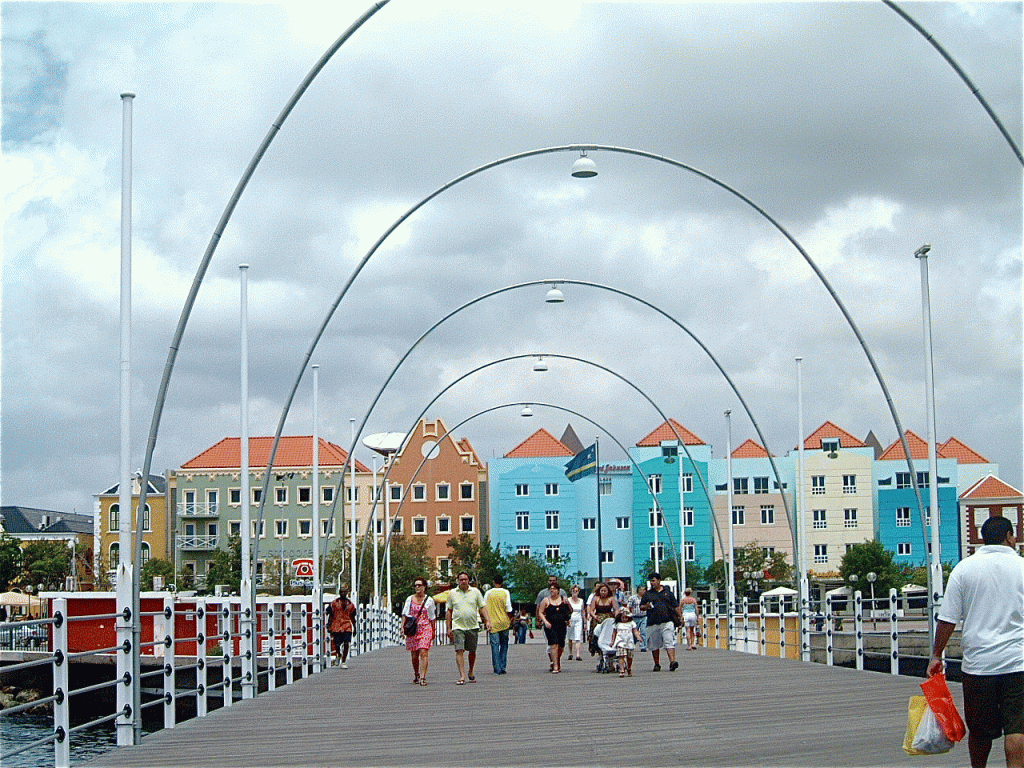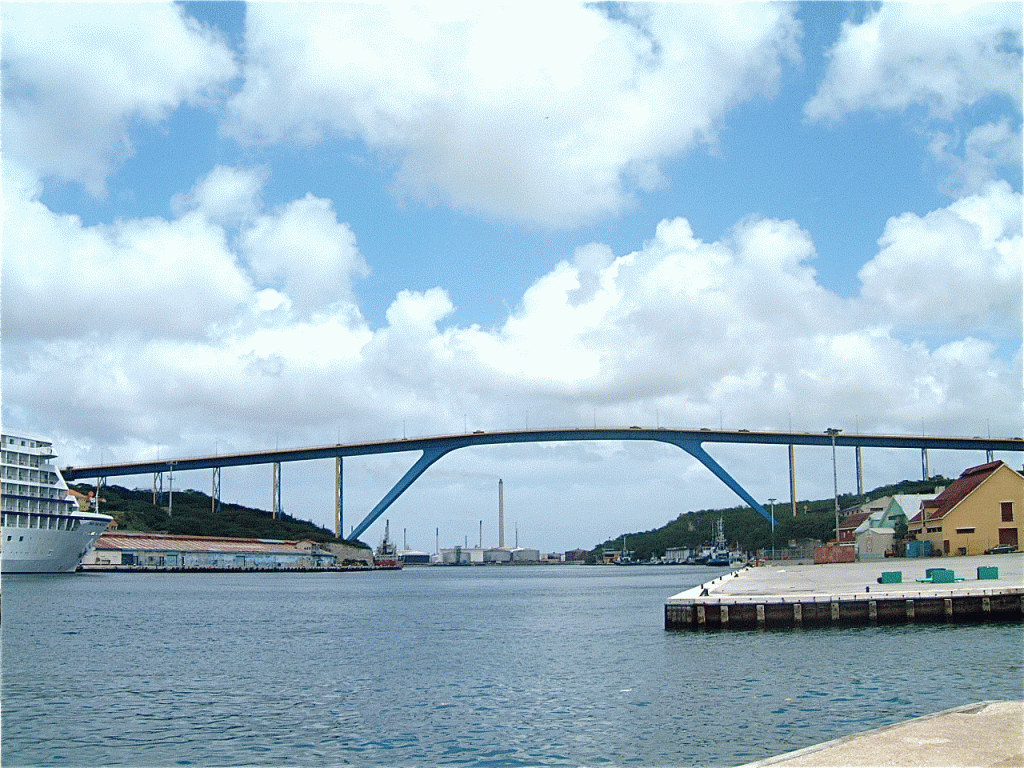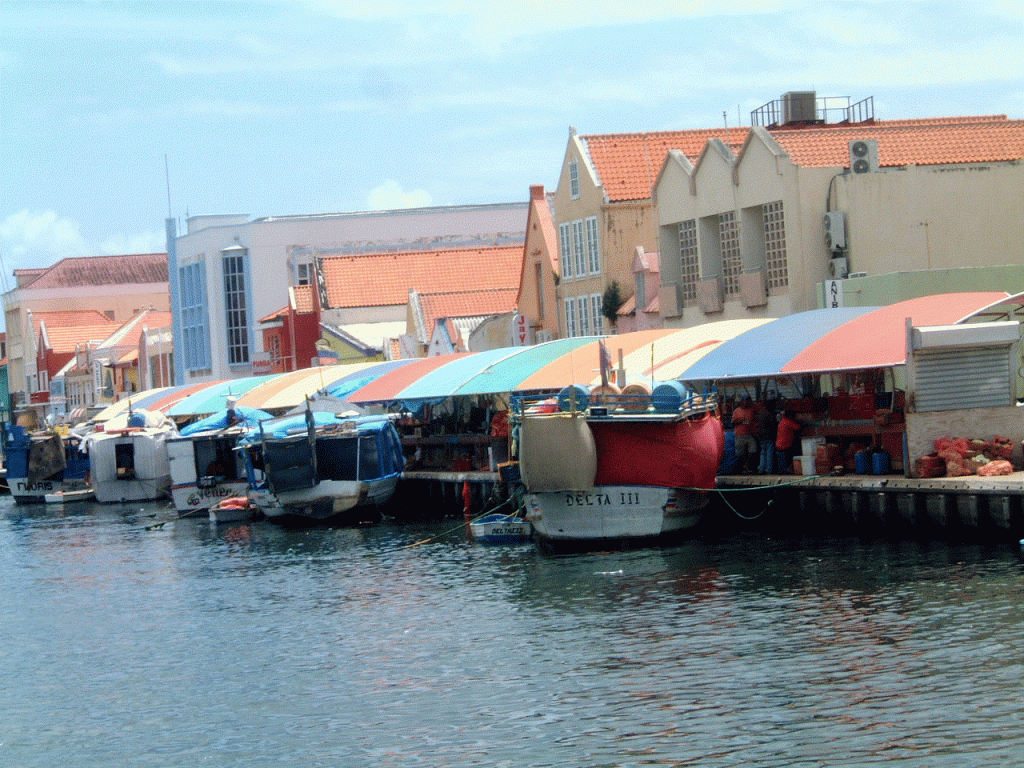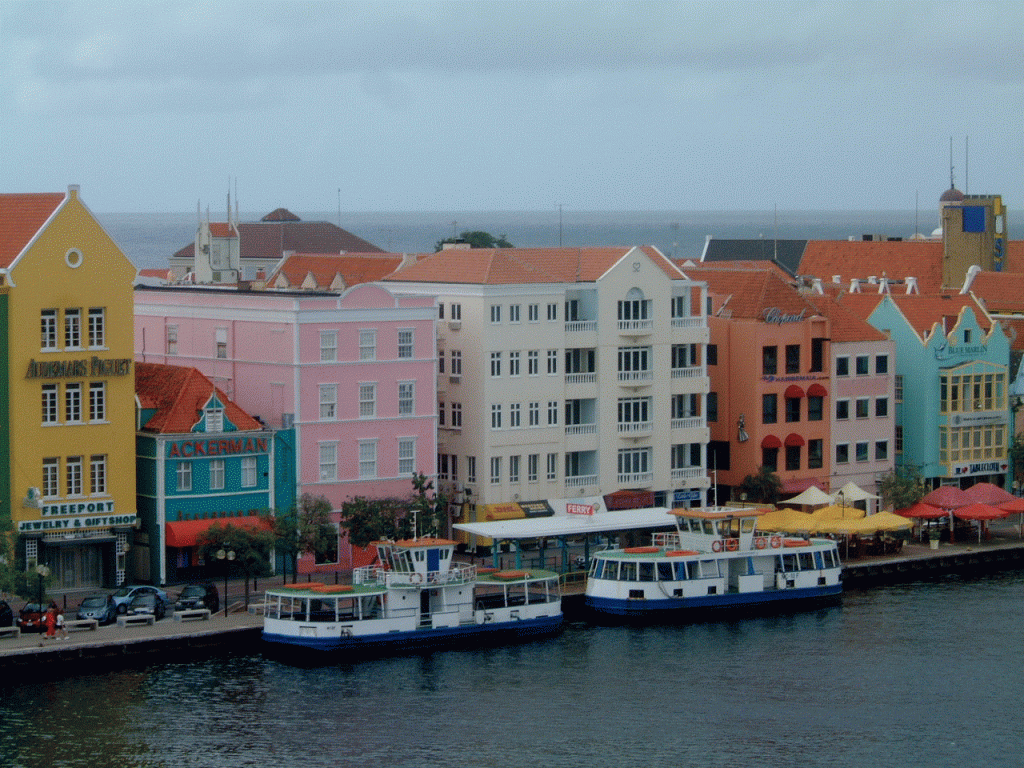She’s “The Swinging Queen”.
No, you’re not hearing the words of a new ABBA song, nor are you reading
the title of a hit tune in a “Mamma Mia” sequel. This Swinging Queen is
Queen Emma, Willemstad’s famous 19th-century pontoon bridge that, without
saying a word, shouts “bon-bini” (welcome) to Curacao.
Queen Emma may be old and pudgy, but Queen Emma still
swings. This venerable old lady, taking it somewhat easier
in her late years, is now closed to vehicular traffic and has become a giant
floating sidewalk for pedestrians.
 |
|
THE |
The floating Queen Emma pontoon bridge splits Curacao’s capital city
of Willemstad into two
neighborhoods: Otrobanda (which literally means “the
other side”) and Punda, the side more known to tourists.
Otrobanda, the “other side” of Willemstad, is traditionally more
residential than Punda. In the 1950’s, many of the area’s stately
mansions, which once housed distinguished professionals and
politicians. Those mansions fell into disrepair when those prominent
families moved to the suburbs. However, serious restoration
efforts began in the early 1980’s.
The neighborhood of Scharloo, across the Wilhelmina Bridge from Punda,
offers an architectural tour of 19th century mansions. The
basic architectural style–as well as the windows, gables, entryways,
roofs, stairways and courtyards–show a wider variety of style and
color than you will find anywhere else on the island.
 |
| WILHELMINA BRIDGE CONNECTS NEIGHBORHOODS PUNDA AND OTROBANDA |
wealthy residents in Scharloo, served as the primary inspiration for
the design of the Marriott Beach Resort & Emerald
Casino. The designers of this resort, tucked away on Piscadera Bay
just 10 minutes from Willemstad, scoured Scharloo to collect paint chips
and details of the tile and wooden ornamentation. Their
findings were used to recreate authentic colors and to scrupulously
incorporate the detail into the interior and exterior of
the resort.
The deep ocher-yellow stucco facade of the resort, along with its white
trim and traditional red tile roof, exemplifies the important role that
color plays in Curacao buildings. In 1817, out of
civic duty, the Governor outlawed houses that were painted
white. The intensity of the reflected sunlight was deemed
damaging to the eyes.
A worthwhile Otrobanda attraction is the workshop of Arawak Craft
Products. At Arawak, you can watch artisans fashion tiny
replicas of local architectural gems. Replicas of typical Curacao
houses are priced upwards from $25.
Punda is the area that offers architecture, shopping, and tourism
attractions such as The Floating Market and Mikve Israel-Emanuel
Synagogue. This 5-block, pastel-painted Punda area of Willemstad offers a
variety of merchandise. Handelskade, the street that goes along
the harbor front, houses the colorful old merchant houses that grace
Curacao’s picture postcards. The major retail establishment of
Penha and Sons is located in the town’s oldest building across from
the Queen Emma Bridge landing.
 |
| THE FLOATING MARKET |
Mikve Israel-Emanuel Synagogue, built in 1732, is Curacao’s major
tourist attraction. In some years it has been known to
attract as many as 15,000 visitors. It rivals Barbados for title of
the oldest synagogue in the Western Hemisphere. However, it does hold the
title of the oldest synagogue in continuous use in the Western
Hemisphere.
an age-old tranquility, the Mikve Israel-Emanuel Synagogue is reminiscent
of the old Portuguese synagogue in Amsterdam. Featuring a lemon-colored facade
and gabled roof, its Spanish-tiled courtyard leads to richly
carved, mahogany doors and paneling. The synagogue’s
floor, carpeted with white sand, is in dramatic contrast to
its lofty ceiling that is adorned with silver and
brass. The sand, symbol of the desert where the Israelites
camped on their long journey to freedom, is also said to
represent the customs of the Jews in Spain and Portugal during the
Inquisition. During those turbulent times, Jews prayed on sand to
avoid being heard by their enemies outside the temples.
 |
| MIKVE ISRAEL-EMANUEL SYNAGOGUE |
a well-earned reputation for religious, as well as ethnic, tolerance.
Catholics, Protestants, Jews, and Muslims have their own houses of worship
and live side-by-side harmoniously. The island also has a
high percentage of inter-ethnic and interracial
marriages. Although over 80% of the population
is Catholic, the small Dutch Protestant and elite Jewish communities
have considerable influence.
From the 79 different nationalities represented in Curacao, the local
language Papiamentu has developed. All the island’s inhabitants
have gradually adopted Papiamentu, a mixture of Dutch, Spanish,
Portuguese, German, African,
and English. (Bon dial means good
day; mashadanki is thank you.)
Curacao is delightfully delicious and its culinary melting pot overflows
with cuisine from Dutch, Chinese, Indonesian, Italian, French, and
Kentucky kitchens. Traditional Dutch favorites
include erwtensoep, a thick savory pea soup that’s a meal in
itself. The locals love iguana soup, made from the
ugly lizard of the same name. They claim it is so
strong it can resurrect the dead from the grave. Keshi Yena, a
whole Gouda cheese stuffed with meat or fish and then baked,
and funchi, a polenta-like cake made of corn meal, are other island
specialties.
A bridge that swings…a market that floats…storybook buildings painted
every color but white…and immaculate streets lined with authentic
narrow-gabled, red tile-roofed houses reminiscent of 17th century
Holland…leave little wonder why the charming Dutch island of
Curacao is considered one of the best islands in the Caribbean.
 |
| STORYBOOK BUILDINGS PAINTED EVERY COLOR BUT WHITE |
JANET STEINBERG is an award-winning Travel Writer and a Travel Consultant
with The Travel Authority in Mariemont, Ohio
